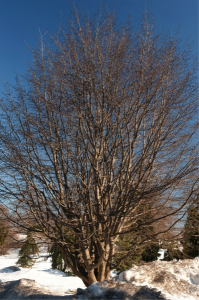Persian Parrotia: A Century of Interest
Posted in Horticulture on April 4 2014, by Jon Peter
Jon L. Peter is the NYBG’s Plant Records Manager. He is responsible for the curation of The Lionel Goldfrank III Computerized Catalog of the Living Collections. He manages nomenclature standards and the plant labels for all exhibitions, gardens, and collections, while coordinating with staff, scientists, students and the public on all garden related plant information.

I feel very fortunate that I get to enjoy one of my favorite trees in the garden on a daily basis. I actually park my car partially underneath its canopy flanking the Benenson Ornamental Conifers parking lot. With such frequent viewing, I get to enjoy the progress this plant makes throughout the year.
Parrotia persica, commonly known as Persian parrotia or Persian ironwood (in reference to its very dense wood) is an excellent medium-sized tree that is interesting in all four seasons. It features similar leaves, twigs, flowers, and fruits to its close relative the witch-hazel (Hamamelis), but is far less common in cultivation.
Parrotia is named in honor of F.W. Parrot, a German naturalist who traveled in the Caucasus region in the early 1830s. The specific epithet persica derives from the tree’s native habitat of the northern Alborz Mountains of Iran and Azerbaijan (formerly Persia).
